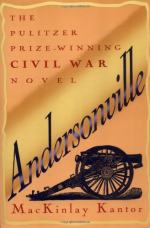“We bore off a little to the right of a large open field on top of a high hill where one of our batteries was pounding away at a tremendous rate. We came up to the main line of works just about at the left of the Fifteenth Corps. They seemed to be having an easy time of it just then —no fighting going on in their front, except occasional shots from some heavy guns on the main line of Rebel works around the City. We crossed right over the Fifteenth Corps’ works and filed to the left, keeping along on the outside of our works. We had not gone far before the Rebel gunners in the main works around the City discovered us; and the way they did tear loose at us was a caution. Their aim was rather bad, however, and most of their shots went over us. We saw one of them—I think it was a shell—strike an artillery caisson belonging to one of our-batteries. It exploded as it struck, and then the caisson, which was full of ammunition, exploded with an awful noise, throwing pieces of wood and iron and its own load of shot and shell high into the air, scattering death and destruction to the men and horses attached to it. We thought we saw arms and legs and parts of bodies of men flying in every direction; but we were glad to learn afterwards that it was the contents of the knapsacks of the Battery boys, who had strapped them on the caissons for transportation.
“Just after passing the hill where our battery was making things so lively, they stopped firing to let us pass. We saw General Leggett, our Division Commander, come riding toward us. He was outside of our line of works, too. You know how we build breastworks—sort of zigzag like, you know, so they cannot be enfiladed. Well, that’s just the way the works were along there, and you never saw such a curious shape as we formed our Division in. Why, part of them were on one side of the works, and go along a little further and here was a regiment, or part of a regiment on the other side, both sets firing in opposite directions.
“No sir’ee, they were not demoralized or in confusion, they were cool and as steady as on parade. But the old Division had, you know, never been driven from any position they had once taken, in all their long service, and they did not propose to leave that ridge until they got orders from some one beside the Rebs.
“There were times when a fellow did not know which side of the works was the safest, for the Johnnies were in front of us and in rear of us. You see, our Fourth Division, which had been to the left of us, had been forced to quit their works, when the Rebs got into the works in their rear, so that our Division was now at the point where our line turned sharply to the left, and rear—in the direction of the Sixteenth Corps.
“We got into business before we had been there over three minutes. A line of the Rebs tried to charge across the open fields in front of us, but by the help of the old twenty-four pounders (which proved to be part of Cooper’s Illinois Battery, that we had been alongside of in many a hard fight before), we drove them back a-flying, only to have to jump over on the outside of our works the next minute to tackle a heavy force that came for our rear through that blasted strip of woods. We soon drove them off, and the firing on both sides seemed to have pretty much stopped.




